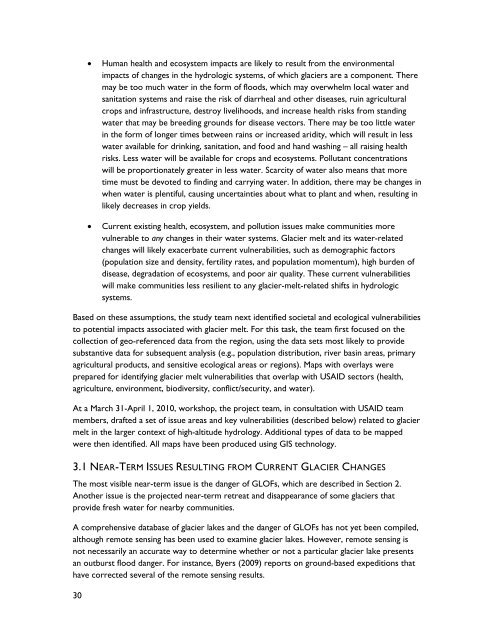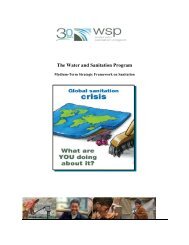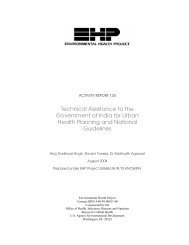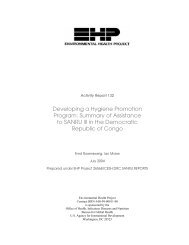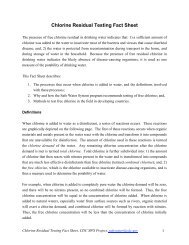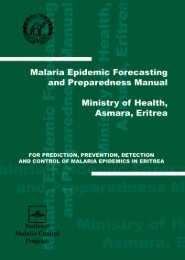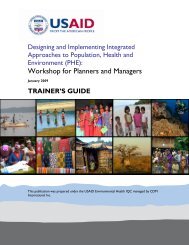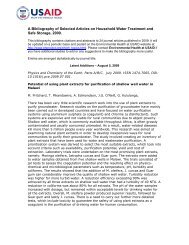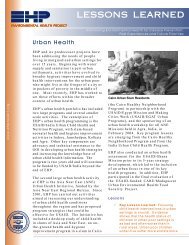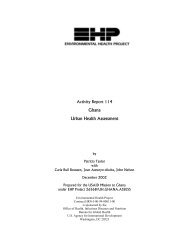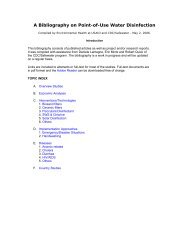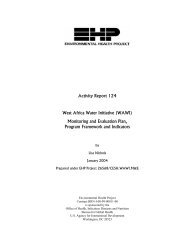Changing Glaciers and Hydrology in Asia - Environmental Health at ...
Changing Glaciers and Hydrology in Asia - Environmental Health at ...
Changing Glaciers and Hydrology in Asia - Environmental Health at ...
- No tags were found...
Create successful ePaper yourself
Turn your PDF publications into a flip-book with our unique Google optimized e-Paper software.
Human health <strong>and</strong> ecosystem impacts are likely to result from the environmentalimpacts of changes <strong>in</strong> the hydrologic systems, of which glaciers are a component. Theremay be too much w<strong>at</strong>er <strong>in</strong> the form of floods, which may overwhelm local w<strong>at</strong>er <strong>and</strong>sanit<strong>at</strong>ion systems <strong>and</strong> raise the risk of diarrheal <strong>and</strong> other diseases, ru<strong>in</strong> agriculturalcrops <strong>and</strong> <strong>in</strong>frastructure, destroy livelihoods, <strong>and</strong> <strong>in</strong>crease health risks from st<strong>and</strong><strong>in</strong>gw<strong>at</strong>er th<strong>at</strong> may be breed<strong>in</strong>g grounds for disease vectors. There may be too little w<strong>at</strong>er<strong>in</strong> the form of longer times between ra<strong>in</strong>s or <strong>in</strong>creased aridity, which will result <strong>in</strong> lessw<strong>at</strong>er available for dr<strong>in</strong>k<strong>in</strong>g, sanit<strong>at</strong>ion, <strong>and</strong> food <strong>and</strong> h<strong>and</strong> wash<strong>in</strong>g – all rais<strong>in</strong>g healthrisks. Less w<strong>at</strong>er will be available for crops <strong>and</strong> ecosystems. Pollutant concentr<strong>at</strong>ionswill be proportion<strong>at</strong>ely gre<strong>at</strong>er <strong>in</strong> less w<strong>at</strong>er. Scarcity of w<strong>at</strong>er also means th<strong>at</strong> moretime must be devoted to f<strong>in</strong>d<strong>in</strong>g <strong>and</strong> carry<strong>in</strong>g w<strong>at</strong>er. In addition, there may be changes <strong>in</strong>when w<strong>at</strong>er is plentiful, caus<strong>in</strong>g uncerta<strong>in</strong>ties about wh<strong>at</strong> to plant <strong>and</strong> when, result<strong>in</strong>g <strong>in</strong>likely decreases <strong>in</strong> crop yields.Current exist<strong>in</strong>g health, ecosystem, <strong>and</strong> pollution issues make communities morevulnerable to any changes <strong>in</strong> their w<strong>at</strong>er systems. Glacier melt <strong>and</strong> its w<strong>at</strong>er-rel<strong>at</strong>edchanges will likely exacerb<strong>at</strong>e current vulnerabilities, such as demographic factors(popul<strong>at</strong>ion size <strong>and</strong> density, fertility r<strong>at</strong>es, <strong>and</strong> popul<strong>at</strong>ion momentum), high burden ofdisease, degrad<strong>at</strong>ion of ecosystems, <strong>and</strong> poor air quality. These current vulnerabilitieswill make communities less resilient to any glacier-melt-rel<strong>at</strong>ed shifts <strong>in</strong> hydrologicsystems.Based on these assumptions, the study team next identified societal <strong>and</strong> ecological vulnerabilitiesto potential impacts associ<strong>at</strong>ed with glacier melt. For this task, the team first focused on thecollection of geo-referenced d<strong>at</strong>a from the region, us<strong>in</strong>g the d<strong>at</strong>a sets most likely to providesubstantive d<strong>at</strong>a for subsequent analysis (e.g., popul<strong>at</strong>ion distribution, river bas<strong>in</strong> areas, primaryagricultural products, <strong>and</strong> sensitive ecological areas or regions). Maps with overlays wereprepared for identify<strong>in</strong>g glacier melt vulnerabilities th<strong>at</strong> overlap with USAID sectors (health,agriculture, environment, biodiversity, conflict/security, <strong>and</strong> w<strong>at</strong>er).At a March 31-April 1, 2010, workshop, the project team, <strong>in</strong> consult<strong>at</strong>ion with USAID teammembers, drafted a set of issue areas <strong>and</strong> key vulnerabilities (described below) rel<strong>at</strong>ed to glaciermelt <strong>in</strong> the larger context of high-altitude hydrology. Additional types of d<strong>at</strong>a to be mappedwere then identified. All maps have been produced us<strong>in</strong>g GIS technology.3.1 NEAR-TERM ISSUES RESULTING FROM CURRENT GLACIER CHANGESThe most visible near-term issue is the danger of GLOFs, which are described <strong>in</strong> Section 2.Another issue is the projected near-term retre<strong>at</strong> <strong>and</strong> disappearance of some glaciers th<strong>at</strong>provide fresh w<strong>at</strong>er for nearby communities.A comprehensive d<strong>at</strong>abase of glacier lakes <strong>and</strong> the danger of GLOFs has not yet been compiled,although remote sens<strong>in</strong>g has been used to exam<strong>in</strong>e glacier lakes. However, remote sens<strong>in</strong>g isnot necessarily an accur<strong>at</strong>e way to determ<strong>in</strong>e whether or not a particular glacier lake presentsan outburst flood danger. For <strong>in</strong>stance, Byers (2009) reports on ground-based expeditions th<strong>at</strong>have corrected several of the remote sens<strong>in</strong>g results.30


